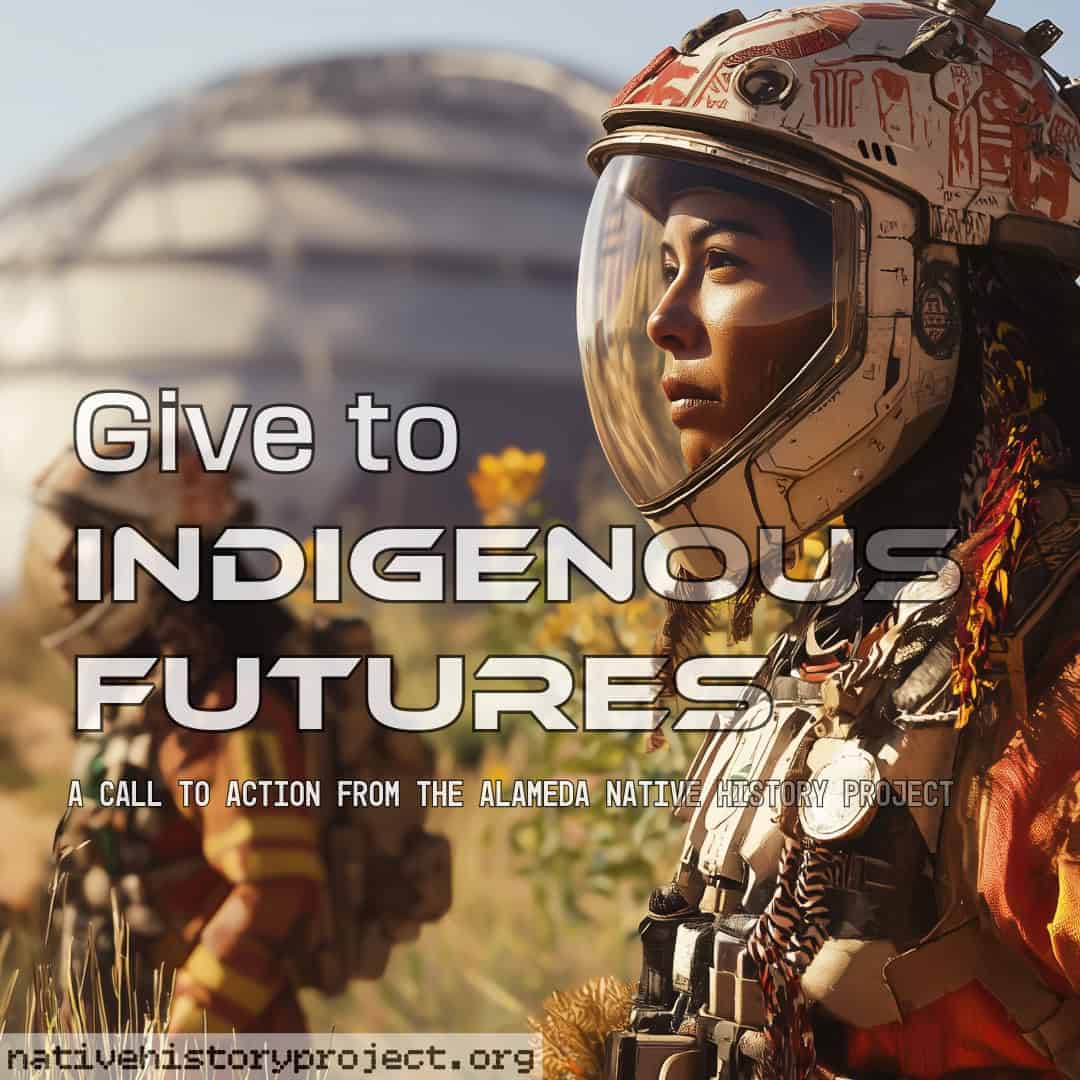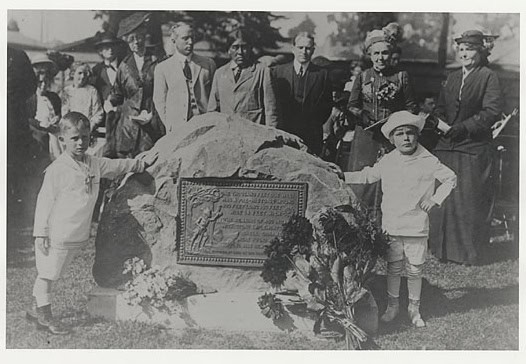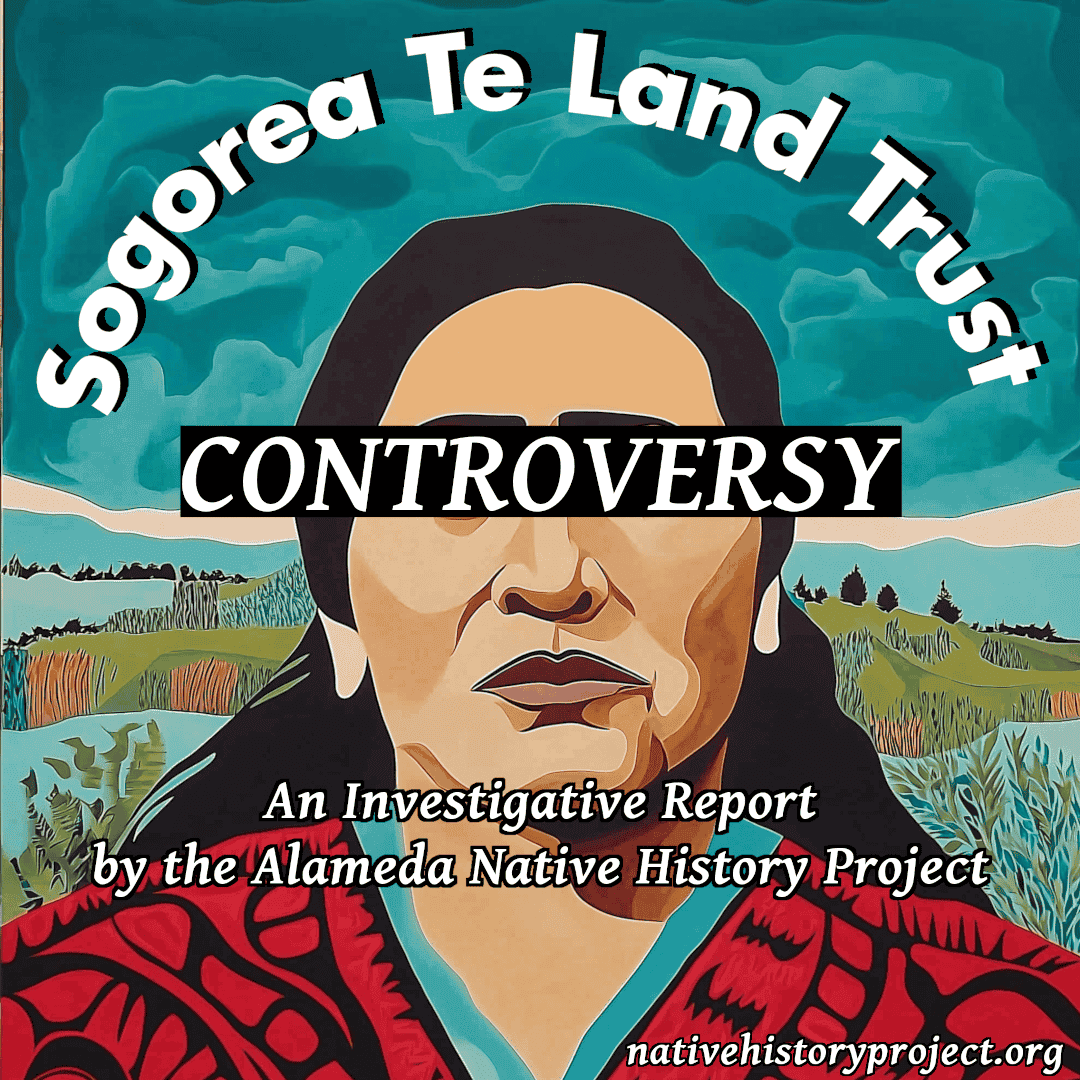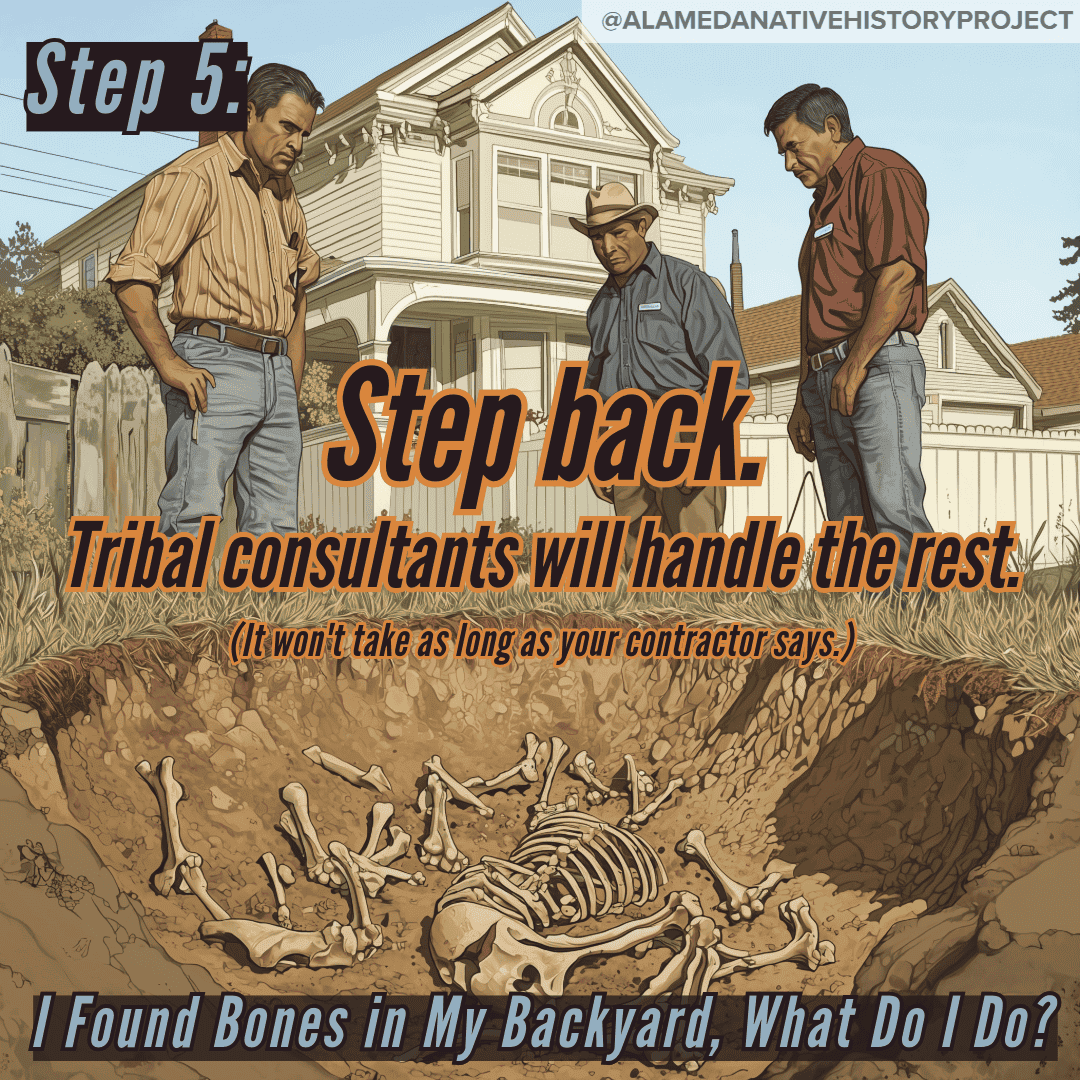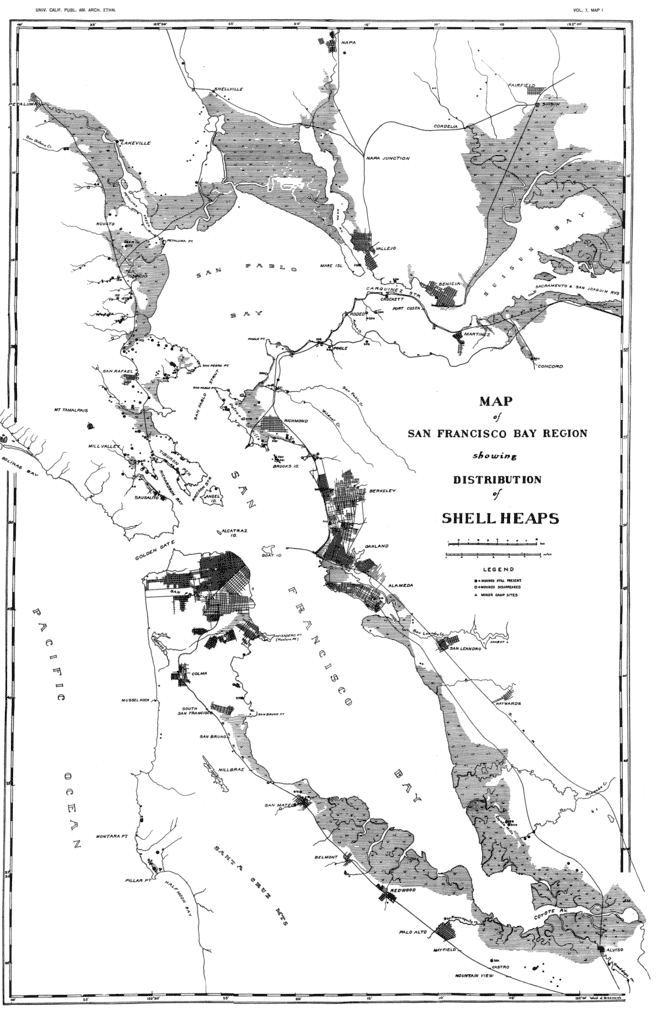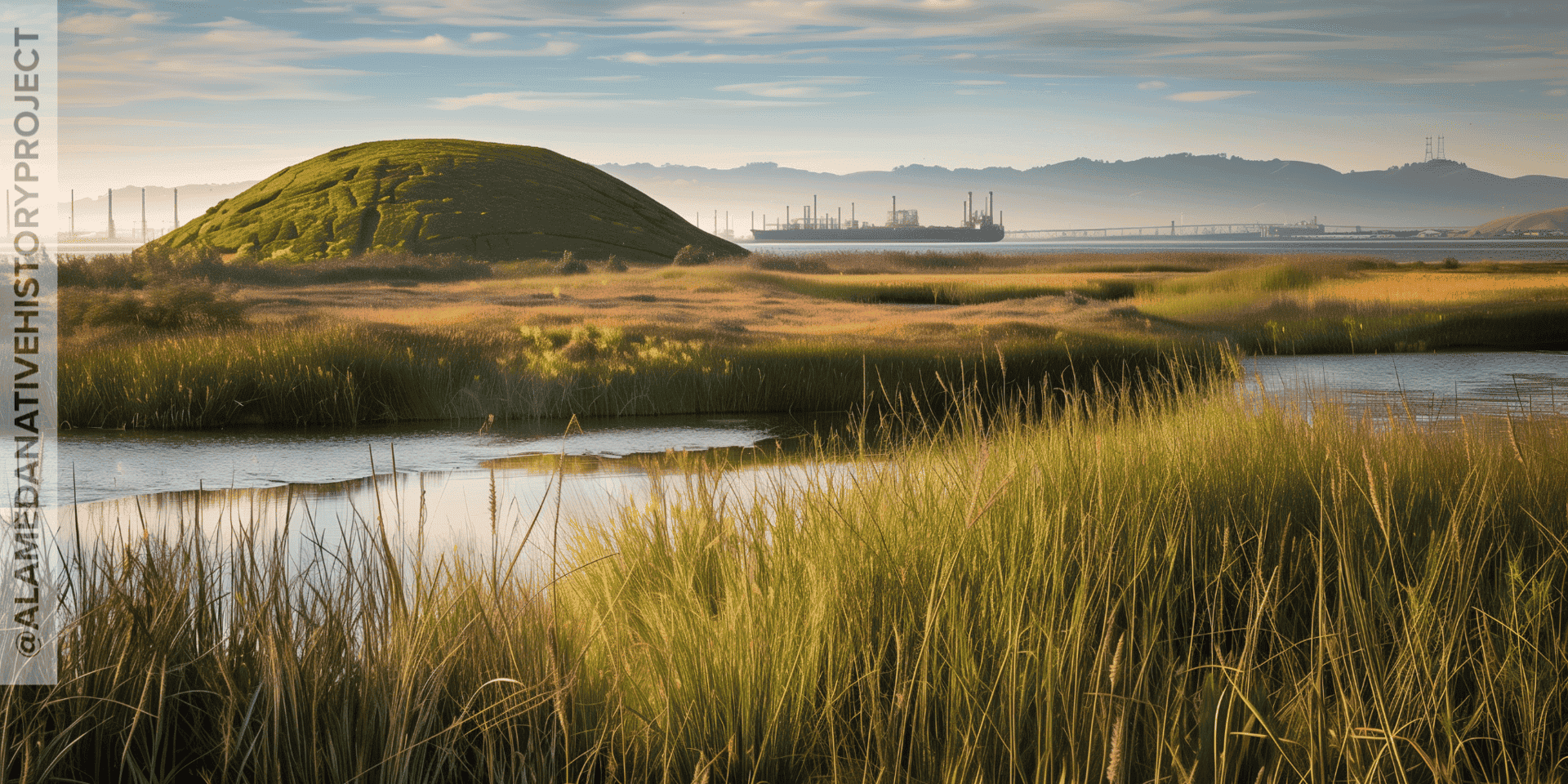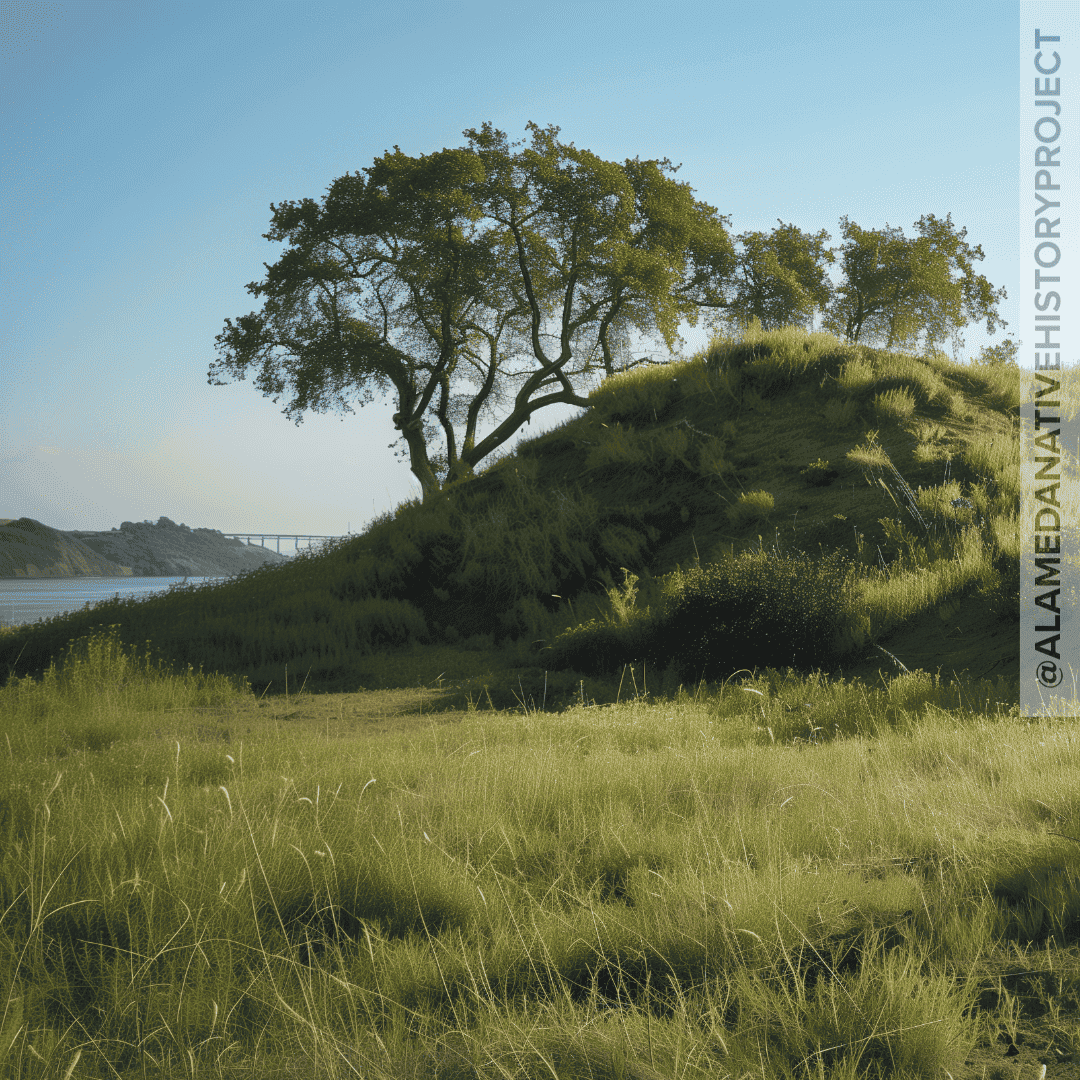
Ohlone people buried their loved ones in mounds long before any of us ever came here.
They’re called shellmounds.
The “Ancient Indian Burial Mounds” of Ohlone people–ancestors of the present-day Muwekma Ohlone Tribe of the San Francisco Bay Area.
They were built long before any of this was here.
Long before some old dead white dudes squatted on what was then a peninsula. Before it got dredged into an Island and eventually called “Alameda.”
Long before this place was called la Bolsa de Encinal to Mexicans, land grant parcels on the extension of former Mission Lands that stretched north from San Jose de Guadalupe, to the Carquinez Strait.
Long before Ohlone were called Costanoan, when Portola came through in who-cares-when. Before the missions were founded in 1776[–which is the same time a meddlesome group of colonists declared their independence from England on the East Coast of this continent.]
Even longer before: when this area was just a valley with a little river in it…..
THIS PLACE HAS BEEN OHLONE TERRITORY SINCE TIME IMMEMORIAL
10,000+ years of habitation meant those shellmounds were real, and big.
There were thousands of shellmounds all over the San Francisco Bay Area. Some of the biggest recorded shellmounds were in Emeryville.
At least 4 shellmounds were right here, in Alameda.
And while many may not exist above ground.
Ohlone Ancestors still lie in wait below.
To be discovered during foundation upgrades, trenching, and in-ground pool installations.
The Shellmounds of Alameda
I grew up in a pre-victorian house on Court Street, about a block away from my grandparent’s house, which was firmly on the edge of the Mound Street Shellmound, around Santa Clara and Mound Street.
Being an Indian kid, adopted out of his tribe from birth, raised on an island that’s just as well known for its racism as it is the former naval air station, things were tough. And, I’ll be honest, I only ever wanted to go home.
So, maybe it was my spirit calling that influenced what I saw as a child. Because my white adopted parents’ money paid for all the psychological and physical testing that proved I wasn’t suffering from some psychosis or more serious condition. [Laying down in a dark room with electrodes attached to my head was an interesting experience.]
I never really got a lot of peace in that house when I was alone. From an early age, I learned not to go too far into the basement by myself. Not necessarily because it was dangerous; but because other things lived there.
The House on Court Street
The Bad Dream Light
Before my sister came to live with us, (she’s adopted, too; and came home in 1989,) I slept in the room which would become hers.
It was a small, narrow room, with popcorn ceiling, and walls; with access to the attic through a panel in the ceiling of the closet.
Next to the was an old “ancient” light fixture which had probably been there since the house was electrified. [It was also moved from the corner of Benton & Santa Clara to the place on the 1300 block of Court Street where this all occurs.]
My dad remembers that I called that the “Bad Dream Light”. He doesn’t remember why specifically. But, he told me, when it came time to pick which room I would sleep in once my sister arrived, I picked the room at the front of the house–not the one with the light.
This is only a footnote about myself that was told to me. And it shrouds the next story in even more mystery because it makes me wonder if it came from the attic.
Ruby In the Attic
My earliest memory of something being a little off seems somewhat inconsequential. It’s more of a passing note.
But, at some point, I remember finding some jewelry in my mom’s jewelry box and somehow knowing that it was the kind of jewelry that Ruby used to wear.
I never met someone named Ruby; and I have no idea how I could know that. But I remember telling my dad that Ruby was the woman who lived in the attic.
Of course, nobody could live in the attic; it was just a crawl space.
This whole thing was forgotten until many years later, into my adulthood, when I remembered this, and asked my Dad who Ruby was. [In fact, I asked both my parents, and my birth mother.]
It turns out: Ruby is the name of my father’s great aunt.
The Procession in the Hallway
I don’t like talking about this. Because, out of all my experiences, this is the one that legitimately makes me seem crazy. Despite the confidence of having had a total psychological and physical work up, and knowing this wasn’t the product of some kind of illness: it’s still something that bothers me to this day.
Have you ever had a light shined in your eyes that you could see even after you closed them? Like a silvery, shadowy afterimage burned into your retinas? Some people call them “eidetic images”, mental images with unusual vividness–an exceptional ability that only children between 6 and 12 are able to possess.
Now, imagine you’re a 6 year old who can’t sleep; so you went into the living room, and are watching late-night/early-morning television on the big recliner in front of the T.V.
At some point, you become aware of something moving out of the corner of your eye. So you look. And what you see is the outline, a silvery shadowy outline of a person. And it’s walking down the hallway.
You watch, as it walks down the hallway, behind the living room wall…. And then appears in the other living room entryway, at the same pace, in the same manner. Just minding its own business.
It can’t be real. Because it looks just like the afterimage of a bright light shined in your face. And you know no one’s there, because it’s too late, it’s night time, and there’s no one there.
But it is.
Except, it’s not minding its business. It has noticed you. So it’s stopped, and turned to face you directly, staring back. With no face, no details, just this weird shadowy figure.
You will the thing to go away, to leave you alone. But it does not disappear when you close your eyes and open them again. It turns back and walks down the hall on its own time.
In the beginning it was just one figure watching me from the hallway. Then it was two or three.
If I kept my eyes on the TV and pretended like I didn’t notice them, they would keep going, only occasionally stopping to look at me.
It terrified me to see them. But my room was also terrifying on its own, too. Sometimes the bed would move, vibrate, or I would … feel like there was something waiting to pour forth from my closet the whole time.
But it wasn’t as simple as just ignoring them.
They never came into the living room. Never approached me. Never made a sound.
But there were so many that the hallway seemed crowded.
Something changed that made it stop. I can’t remember what.
But it’s worth noting that from the time I was born and lived in that house, the neighboring block, the former site of Lincoln School, had been razed and was being developed into the south-west inspired houses that sit there now. [From 1986 to 1991 at least.]
Considering how many burials are still being unearthed in 2025: Who knows how many burials were hiding just below the surface of the former high school grounds.
Is it possible that I saw Ohlone ancestors wandering through my house, searching for their way back home? Or were they the figment of an overactive imagination?
The Basement Double
Because the house had been moved from its original lot at Benton Street and Santa Clara Avenue, it never had a real foundation. At some point, my dad had paid for a foundation to be built underneath the half that held our bedrooms, but the rest of the “foundation” was a collection of 4×4 posts sitting on piles of bricks.
This meant the “basement”–the ground floor of the house–was mostly dirt, covered by plywood.
The basement was always spooky. Not because it was dark, or dangerous. But because I could tell something else lived there. And that I was an interloper. It’s a feeling that never left me, no matter how well let, or how cozy it ever became.
When it was still mostly unfinished, the two most recognizable rooms were the laundry room, and the workshop. Early on, my dad spent a lot of time in both. Mostly doing laundry, and sometimes tinkering in the workshop. If he couldn’t be found upstairs, he was downstairs doing either.
To get to the “basement”, you would go out a side door in the back of the house, and walk down a staircase that wrapped around to the exterior door–which was padlocked shut when no one was in there.
Usually, I could be left to my own devices. I would entertain myself or play games, read books. But at this point in the day, I got bored and went looking for my dad.
I checked the bedrooms, the kitchen, and the bathroom. No one was around. So, I figured he was probably downstairs.
When I poked my head out of the side door, I saw the back of him turn the corner at the bottom landing.
I shouted, “Dad!”
And jumped down the stars a landing at a time. Reaching the bottom and turning just in time to see him disappear into the basement.
At this point I’m thinking he’s playing a game. So I rushed into the basement calling out for him.
But the basement was dark. There was no sign my dad was down there. The washing machine wasn’t running. There were no lights on anywhere, not in the workshop. Not in the garage.
I realized very quickly that I was alone.
That, maybe, this was a trap.
And with these realizations, things started to feel like they were closing in on me. I felt exposed. Viscerally. Almost … in danger.
Even though I knew I should probably run, I felt frozen.
It wasn’t until I heard the toilet flush upstairs that I was able to gather my wits, and zoom out the door.
I caught my dad just as he was coming out of the bathroom door.
Not wanting to let on about the terrifying experience I just escaped, I cried, “Oh, there you are!”
The Vertebra
I found a bone in the dirt in this little room in the back of the basement. The room itself was squared off by walls, and it had a large step of poured concrete, much like a bulk-head–but very much unlike every other part of the basement. This looked like the most built up part of the whole house to be honest. Even though it lacked real walls, and a real floor.
I was messing around in the dirt in the back there, because it was so powdery and light. It was just dust, I liked running my hands through it because of its smooth, silky texture.
And that’s when I found it.
A bone, pale, pitted, but whole. With no obvious cuts or missing pieces: I could tell it was a vertebra. [Because reference books were my only friends.]
When I showed my mom, she told me it was a dog.
Or a cow, when I pushed back. But I knew.
I kept that bone for years. The last time I saw it was in my room, on my bookshelf. But I can’t tell you where it is today. It’s probably somewhere in storage, waiting to be re-discovered.
Living on a Haunted Island
My house wasn’t the only place where I experienced things. Most of Alameda is haunted by its own past. The Shellmounds of Alameda had long been used as overspread, the bones of Muwekma ancestors used for fertilizing rose bushes … and paving Bay Farm Road.
But even its more contemporary history echoed in the abandoned halls of buildings long forgotten.
My personal history of exploring the abandoned buildings on the former Alameda naval air station as a teenager is extensive.
And some of the most heart-pounding experiences I have ever shared with my friends have taken place in buildings that no longer even stand today.
This is not to introduce a story so far away from home as it is to introduce the fact that I have had experiences which have been shared and witnessed with other people.
The Swaying Woman in the Closet
At some point during my teenage years, I had removed the door from my closet. My childhood fears of what lurked inside had been abandoned.
In that version of my bedroom layout, my bed was positioned directly across from the closet.
One night, a friend was sleeping over. The lights were off. We were getting ready to go to sleep. I was just starting to relax when I noticed some movement out of the corner of my eye.
In the doorway of the closet, there was the outline or shadow of a woman with long hair.
She was standing there. Her feet were planted. But she was swaying side to side–moving left to right unnaturally fast. Ping-ponging in place between the door jambs.
No human could move that way. And no one else was in the room besides us. This woman wasn’t really there. Even though I could see her, and feel her angry, unsettled energy.
I saw it. But, I didn’t say anything because I didn’t want to scare my friend.
After a moment, they asked, “Do you see that?”
Which meant they saw it too.
I just replied, “Go to sleep,”
And pulled the blanket over their head.
Rosa in the Den
Rosa was a rescue dog from Guatemala. A collie type dog with calico colors and spots.
At this point, I was in my 20’s. The house had been renovated almost a decade ago, so there was a den in the basement now, with a real locking door to the rest of the still-unfinished basement.
My sister’s dog had recently passed. He was a miniature Dachshund who succumbed to old age. This happened not long after.
Rosa and I would sit downstairs on the couch in the den and watch TV together. (She had actually started watching it with me, commenting in her own way on what was happening on the screen. Which was … almost more fun to watch than TV.)
Tonight was no different.
Except, Rosa suddenly cued up on something.
She started, and looked at the recliner across from us. Then she seemed to watch something go from the recliner to the floor. And continued to track something as it went under the coffee table directly in front of us.
Then she let out a whimper. And covered her eyes with her paws.
I couldn’t ask her what she saw. But it seemed like it was small, almost like another animal. I still wonder about it to this day.
The Bureau Shadow
Sometimes it was hard to tell if I was just imagining things. If something was really there. Or if I were somehow picking up on the echoes of the past.
Upstairs, on the main floor, the renovations to the house saw an addition of a bathroom in my parents’ room, as well as the removal of the walls separating the living room from the hallway and the dining room. We now had an open floor plan, and stairs leading down into the den from the dining room.
Other changes had been made. For instance, the front door now had a frosted glass oval window in the center, and another window frame on top. This allowed the porch light to illuminate the whole space with a gentle glow.
I could basically walk in a diagonal line from my room to the bathroom. I guess that’s not really a big deal now that I think of it. But I wonder why I didn’t just take that route one night when I saw a shadow in the hallway.
It wasn’t one of the things I used to see walking through the hall when I was younger. This was different.
In the hallway, along the wall between my sister’s bedroom door–the narrow bedroom between my parents’ and mine … was a bureau of draws, about waist height, with a mirror mounted lengthwise on top.
It was long, sturdy. And it used to belong to my mom’s parents. My grandmother used it, and it used to have a picture of me and her wedged in the frame. But that was long ago.
Now it was in the hallway. And it held linen and place settings for the dining room table.
But there was something else there tonight.
A shadow of a person. Standing in front of the bureau, its hands flat on the table top, gazing into the mirror.
I could have walked around it, like I said. I probably should have. But, for some reason, I didn’t. I thought, like all of the other strange things, it would just disappear as soon as I came too close to it.
I was wrong.
It only became more solid the closer I got.
Until I was standing next to it.
Realizing that it was blocking the light.
And that I could sense its presence like you can sense someone standing next to you.
I didn’t walk through it. I didn’t touch it. In fact, I moved around it, and said, “Excuse me”, as I passed.
Then I went into my room. Locked the door. And didn’t leave for the rest of the night.
The Grandparents’ House on the Shellmound
My dad’s parents lived three blocks away from us. At about Santa Clara Avenue, and Mound Street. Well within the bounds of the shellmound on Mound Street.
I never felt alone in that house. And I never really felt at ease. It always seemed like I was just one corner away from seeing something I was really prepared for. Whatever that thing would be. I felt it lurking in the walls, behind every door, and inside every cabinet.
The place vibrated with a strong, unsettling feeling. Even outside, I felt like everything inside was watching me through the windows. Was waiting for me behind the trees. Even in the open space of the backyard, the detached shed–which was actually a nice, newer, single room building–had that vibe to it.
Something not necessarily foreboding, but just not entirely welcoming or at-ease.
I was the most scared of the dorm room on the third floor my dad and his three brothers (my uncles) shared growing up. But the basement–real basement–with my grandpa’s den and the cellar were a very close second. However, I felt like I could stay there for a little longer without feeling too creeped out.
Up on the third floor, I became paranoid that things were happening on the floors below me, just out of sight. But down in the den, I didn’t want to turn my back on anything.
My fear of the house was so strong that I never wanted to stay the night. Ever. And I don’t think I ever stayed more than one night at any time.
The last time I slept there, I slept in the living room on the couch because I didn’t want to go any deeper into the house.
My dad’s cousin said he and my uncles used to dig up arrowheads in the cellar. I never ventured onto the dirt over there. Even after both my grandparents had passed, it was my job to pack up the house. My partner at the time was there, working with me.
Our workflow was to pick up stuff, wrap it in packing paper, then put it in a box, label the box, seal it up, and transfer it to storage.
One of the first things I did was teach myself how to use the security system, and assign myself and all my family members separate pins for the alarm. It seemed important because I wanted to make sure the house was secure since no one was living inside it anymore. It was a basic system that chimed and announced when a door or window was opened.
So my partner and I had managed to make really good progress on packing everything up, and had managed to work our way down to the den.
At some point, we ran out of some packing supplies. My partner stayed working in the den as I locked the door and left to get more.
When I came back, he was visibly shaken. And he wanted to know if I had come back earlier.
When I asked him why, he told me that he heard someone come into the house, and walk all the way to the back room, where my grandparents used to sit and watch TV all the time.
No one else was in the house. The alarm would have announced an open door. But there was no record of any event other than my return.
Maybe I never saw anything in the house because I never wanted to. Because I was scared enough just being there that I didn’t need to.
I still dream about both my childhood house, and my grandparents’ house. They’re usually nightmares about growing up on the burial mound.
It wasn’t until I started doing local research that I learned about the other shellmounds in Alameda.
I know I’m not the only one who’s had these experiences.
Hopefully this gives other people the courage to reach out and share theirs.
Thank you for reading this.

